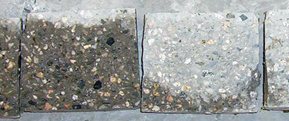 Absorption testing is a popular method of determining the water-tightness of concrete. A water absorption test, such as BS 1881-122: 2011 Testing Concrete: Method for Determination of Water Absorption, measures the amount of water that penetrates into concrete samples when submersed.
Absorption testing is a popular method of determining the water-tightness of concrete. A water absorption test, such as BS 1881-122: 2011 Testing Concrete: Method for Determination of Water Absorption, measures the amount of water that penetrates into concrete samples when submersed.
The lower the absorption, the better the result; however, as do many durability tests, there are limitations:
- It doesn’t account for any type of reactive process that ties up water;
- The assumption that all the weight gain is due to water; and
- There is only a short duration of submersion compared to what might happen in long term conditions.
Furthermore, absorption testing can result in misleading results when it comes to the use of concrete admixtures. Chemicals, such as those in hydrophilic crystalline waterproofing admixtures like Kryton’s Krystol Internal Membrane (KIM) react with water and the unhydrated cement to form millions of needle like crystals that block the flow of water through concrete. Unfortunately, absorption testing measures the amount of water that penetrates into concrete samples when submersed, yet fails to take into account the inherent use of water in the crystallization process,  especially in the early stages of curing.
especially in the early stages of curing.
The absorption tests will improve over time – as the concrete is saturated and crystals continue to grow. Therefore, when testing durability of concrete that has a crystalline admixture within the mix-design – testing the absorption at later stages will give more realistic results. To acquire the most accurate results, test the concrete at 56 or 90 days, rather than the early stage of 28 days.
In the end, you are looking for the most definitive results in this process. The importance of concrete durability cannot be underestimated, especially when hoping to build a sustainable concrete structure that will last well into the future.
This is a far better method than the RCP test, which we will talk about next. However, there is another test where many of the absorption test limitations are avoided.






